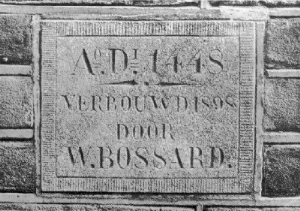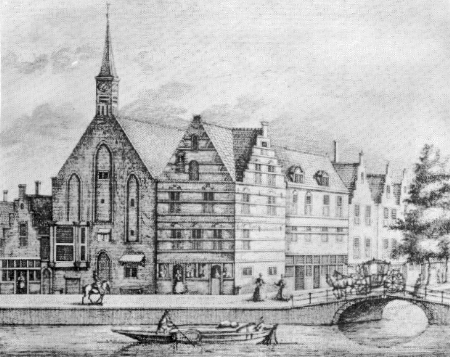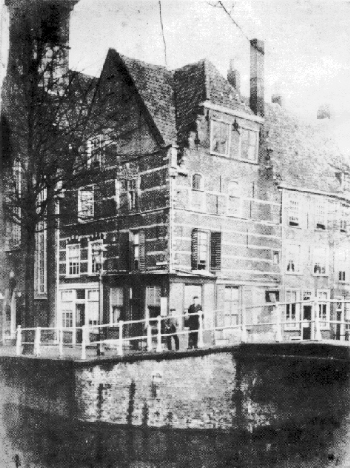In 1972 a booklet about the history of “Het Noorden” was made. The booklet, appropriately called “Het Noorden,” is dedicated to Fiep Garos during the reopening of “Het Noorden” on October 23th, 1972. Below is a digital version of this booklet, which was in Dutch, and was translated later.
In 1972 a booklet about the history of “Het Noorden” was made. The booklet, appropriately called “Het Noorden,” is dedicated to Fiep Garos during the reopening of “Het Noorden” on October 23th, 1972. Below is a digital version of this booklet, which was in Dutch, and was translated later.
After the death of the owner, Jan Garos, the MV received the management of “Het Noorden”. In 1966 the MV became the first and only study association in the Netherlands with its own café. Café “Het Noorden” is still open on Wednesday for the miners to have a beer. For the Extraordinary members the well-known “Barbaraborrel” takes place on the first Friday of the month. Here, mining engineers and senior students can exchange their experiences.
Foreword by the authors E. van den Brand and W. Kramer
In compiling this short piece of text about “Het Noorden” we received valuable advice from many sides, for which we would like to express our gratitude here. Especially Mr. J.J. Prins for his impression from the time during which Jan Garos was still behind the bar, and the municipal archive of Delft for the disinterested cooperation during the collection of historical data.
‘Het Noorden’
Around the beginning of the 15th century coal was mined in the area of Worm in South Limburg for the first time on a more or less regular scale: the first miners were born. In the same century, industrious craftsmen in Delft started the construction of the buildings at the Noordeinde and the Kolk. Whether the coincidence of these two events is due to a cosmic event, or due to mere chance, cannot be traced in history. The fact is, however, that in the current century the historical development of both events culminated in the link between “Het Noorden”, and the Mines, in which Jan and Fiep Garos were indispensable factors.
Much has already been written about the history of mining, but little about the history of this illustrious building. Even less has been written about the band that arose at this location between Mining, Jan and Fiep Garos and “Het Noorden”. Therefore, it is intended to fill in a part of this gap with the following text:
For centuries the building has undergone few changes, but drastic renovations took place around the turn of the century . It is therefore not unlikely that a lot of original information about the house was lost with these renovations. Since one of the owners has a feeling for the historical we can still date the property. During a renovation in 1898, a facing brick was installed, which states that the building dates from 1448, presumably based on data from an earlier plaque. This stone is now bricked in on the Noordeinde side of the house. This would mean that the original building dates from the same time as the neighboring Lutheran church, which now has historical value.
The fact that the houses appear in pictures only after about 1550 can be due to the non-availability of artists who select cityscapes as objects for to sketch. However, it cannot be ruled out that the building with the neighboring church were in a “bad light” for many an artist. On the first engravings and stone prints the house is in fact described as “Dolhuys” (asylum). The accompanying engraving was made around 1730, and probably on the basis of an older picture, because in 1645 a glazier named Jan Dirk (according to the tax registers) appears to have bought and occupied the property, which does not seem like a “crazy idea”.
This image immediately captures a special feature: the Noordeinde façade is of a tight triangular shape, while that of the Kolk has a stair shape. It is known that for economic reasons the façade was kept straight, but it is also possible that the façades were built in different periods, which is, however, nowhere likely.
After changing ownership several times in the 17th and 18th century, about the Napoleonic era we found some more information regarding the inhabitants. Full-time civil servants set out to keep the first census between 1815 and 1852, and it quickly became clear that beer and a bar in a part of the present-day café had taken a definite place. However, they needed help from outside, because as a “barman” the Tasferon from Leiden came to be registered. Since then we have seen in the annals a resident of the building that carries out the tappers office, whether or not combined with professions such as butcher and baker. Before 1898, the situation we see in the adjacent picture has changed very little in comparison with the previous engraving. Only the top façade on the Kolk side has changed, presumably because it started to be in a state of decay and was therefore dangerous. Even layout and number of windows and doors are still accurate with the engraving.
However, this changed in 1898. At the Noordeinde 4, the widow Vogel-de Goeyer still practices her profession as coffeehouse owner, but the property on the Kolk side is sold as a bakery and shop. The new owner immediately starts with a renovation, the result of which can be seen on the adjacent image. Most striking is the extra floor and the fact that the front of Noordeinde 4 has in fact been cut in half. The new corner building was in fact built through the old house, which is the reason why the layout of the remaining buildings showed a somewhat fragmented connection.
These were the conditions, when Petronella de Lijster, the mother of Jan Garos, bought the buildings in the beginning of this century, i.e. the houses at the Noordeinde 4 and Kolk 2. Initially she stayed in the Poppesteeg to firstly open a café on the Noordeinde around 1910. In 1913, the house is rebuilt on the Kolk, on the occasion of which Jan and his brother Cornelis lay a stone, which is still in the front of the building on the Kolk. In 1916 the house at Noordeinde 4 was finally renovated and in this state the building remained until the last renovation.
When Jan Garos took over his mother’s cafe in 1928, the period of Jan Garos, the Miners and “Het Noorden” started. It is clear that without an idea of the people who populated the café in the following years, a story about “Het Noorden” would not be complete, hence the next impression of a regular guest.
At the reopening of the revamped “Het Noorden”, we, the old miners, enjoy the sight of the old bar, behind which Jan Garos is launching advisory remarks, punctuated with powerful terms. A modernised kitchen, from where it will be difficult to produce dishes of the same quality as Fiep Garos did in the old kitchen, which was already enlarged before 1940.
Modernized toilets instead of the couple in which you got a shower for free during rain, and as far as the enclosure is concerned, the dangerous connection with a loose shelf above the inner courtyard between Noordeinde and Kolk is no longer necessary. The old mining table is fortunately there, – although somewhat worn –in full glory.
When the mining center “Het Noorden” assumed more form in 1931, it was decided to have a mining table made. It was quickly made, and Prof. dr. Caron was prepared to cast a copper miners’ emblem from Falun’s copper ore. When the result showed quite a few casts, Jan Groote, the amanuensis of Docimasie, poured it over and the result still stands in the middle of the table. This mining club was not accepted in the beginning by some members of the sociability associations, but the physicality of the miners was so powerful that every disturbing element was worked out of “Het Noorden” in a harsh way. However, the spirit in “Het Noorden” and Fiep’s food were such, that after a few years a core of non-miner-regulars had formed, including the maker of the painting “Dorst” (Thirst).
Girls and other female persons were barred in the first few years. Occasionally a few chosen girls were allowed, if they drank a beer. Married miners did not exist because this virtually nil the ability to get a job. It was also a custom that the excursionists and “practical workers” from different countries brought along souvenirs that adorned the walls. The graduates started to give their beer party at Jan’s, where in the beginning no family or girls were present. Sometimes an individual forgot to pay his bill in full or in part, which was recorded in Jan’s booklet, and it is again typical of him that he determined that this booklet had to be destroyed after his death.
The aftermath of 1932 generations of miners, even though they were members of a sociability association, accepted Jan and Fiep as an “institution” belonging to mining. The café “Het Noorden” was now gradually becoming a miners club with well-known old permanent citizen customers, and the Sunday Jass club, where often a fourth man a miner joined in.
Then came the war and the resistance, in which the miners were involved from the first moment. Prof. dr. Mekel was one of the first executed resistance fighters. The occupation drove the people towards each other, of course not suddenly, but gradually, and “Het Noorden” became more and more Jan Garos, and not only for miners, but also for many others, especially after the closure of the associations,. His heart was with the students, miners, Lagaaiers, for which Fiep was able to provide sufficient food in 1941. She was the sorceress, who managed to prepare a tasty meal in this increasingly difficult food time, even until the winter of hunger 1944-45.
Although you had to let know in advance whether you came to eat, unexpected guests were rarely sent away with empty stomachs. After the dinner came the beer and the coziness. Jan stood like a rock behind the bar and it sounded: “’day Jan, Old Giant” Pilsje Ben? “Connect a new barrel at the cellar”. With the rationed drinks deliveries, there was usually something to drink for the regulars. The loyal Sunday morning customers received a drink from Jan until the end of the war.
Loyal dedication and utmost discretion were the greatest merits of Jan and Fiep, as well as their affection for many students, especially for those who worked in the resistance. They took great risks for this. There was also a secret hatch that allowed the students to flee to the attic of the adjacent church during raids. In “Het Noorden” agreements were made, meetings were arranged and things that were illegal were discussed. Jan and Fiep were like the three monkeys: They heard nothing, Saw nothing and Spoke about nothing. The bond between the miners meant that they, as a group, were less willing to be chased by the occupiers. This was shown by the percentage of “drafters” and German gangsters; the lowest of the T.H. “Het Noorden” became a symbol of togetherness of the miners. One of the most important resistance fighters, the miner Loet Hesselberg was a regular guest. His parents were imprisoned in the Indies. He was secretary of the student resistance that worked closely with the national resistance (including providing false identity cards, distribution vouchers, food etc.). In early 1945 he was arrested together with the regional resistance leadership and executed under his pseudonym, making this fact unknown for a long time. It is understandable that between Jan, Fiep and the miners, and many other students, a close bond arose, very different from the pre-war miners.
After the war, the DSDG “Iam Repleatur Gario” spontaneously arose, the words of a traditional student song with the phrase ‘Ha, die Ouwe Reus’ and as Golden Honorary Member Loet Hes.
As a token of appreciation for everything they did for many DSC members, “Het Noorden” was allowed to wear the Corps weapon. “Het Noorden” became a case that was mainly visited by students. The Wednesday night was for the miners, for whom Fiep made a cheap evening meal. Also in the “Iam Repleator Gario”. ‘T Keldertje and other companies had regular evenings.
After the death of Jan in 1966, It became too demanding for Fiep, and the likely sale of the buildings was discussed. The former miners saw the eventuality that “Het Noorden” was going to close forever, and many plans and conferences were held, always meeting Fiep and Cas’s wish to keep – if possible – “Het Noorden” for the miners. Even the possibility of purchase by a consortium of former miners was seriously discussed.
The solution was found in selling it to Delft Student Community (DSG). Agreements were made, in which Fiep’s participation in particular was of great importance to retain “Het Noorden” for the miners. The exploitation was assigned to the Mining Association and a guarantee fund was quickly brought together by former miners in order to absorb any negative results. Because of the excellent way in which the MV discharged this task, it was not yet necessary to appeal to this fund.
And now a renewed “Het Noorden” has opened to the MV members, who only hear these difficult times of war, but they see that the history of “Het Noorden” and the miners are closely linked, and that the Wednesday evening must stay. When this happens as in the last years and a content can be given, then “The North” will experience many mining evenings. We can certainly count on the support of former miners.




